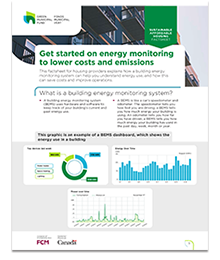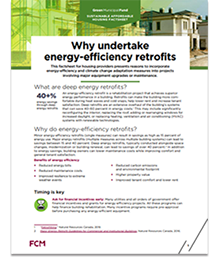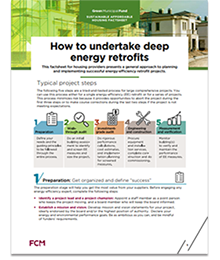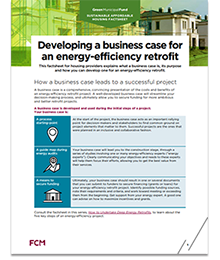
Our Sustainable Affordable Housing (SAH) initiative supports local affordable housing providers in retrofitting existing units or constructing energy-efficient new builds. The initiative is accessible to municipalities, not-for-profit organizations and housing cooperatives looking to improve their communities with sustainable affordable housing.
These six factsheets provide a guide to successful projects and outline the benefits they provide, including increased affordability, lower energy costs and better quality of life for residents. Whether you want to make your current buildings more efficient or design a high-performance new build, these resources will provide key insights to help achieve your performance targets.
Installing an energy monitoring system
Why install a building energy monitoring system?

A building energy monitoring system can help you understand energy use so that you can save costs, improve operations, and reduce greenhouse gas emissions. This factsheet will help you get started on energy monitoring. You’ll learn about how the system works, its many benefits, and the importance of tracking your building’s energy use.
Read: Get started on energy monitoring
Retrofitting existing housing
Why an energy-efficient retrofit?
This factsheet outlines what constitutes a deep energy retrofit, the benefits they provide, and the various ways you can achieve them. You’ll be provided examples of improvements you can make to improve a building’s energy efficiency, and how you can bundle them to achieve maximum savings.
Read: Why undertake energy-efficiency retrofits
How to retrofit in the climate era
Whether you’re planning a single retrofit or a series of projects, this five-step process for planning and implementation will help you complete the project on time and on budget. From preparation to measurement and verification, this process minimizes risk and is tried-and-tested for comprehensive projects.
Read: How to undertake deep-energy retrofits
The business case for deep energy retrofits
A well-developed business case will streamline your decision-making process and help you get funding for more ambitious projects. Discover what constitutes an effective business case and how to develop one to secure funding for your project.
Read: Developing a business case for an energy-efficiency retrofit
Building new housing
Why your new affordable housing should be high-performance
Designing and building for higher energy and environmental performance than current building code requirements has many benefits. Learn more about high-performance buildings, their key attributes, and potential certifications to consider.
Read: Why build high-performance affordable housing?
How to build energy-efficient affordable housing
Effective planning of high-performance buildings involves a collaborative design process with a team of professionals who typically work independently on their part of a project. This factsheet presents the five steps of an Integrated Design Process for a successful high-performance residential construction project.






